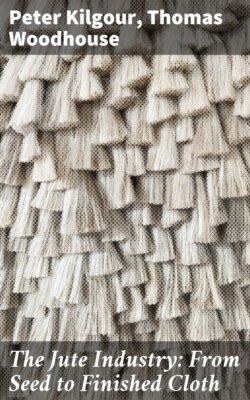Читать книгу The Jute Industry: From Seed to Finished Cloth - Thomas Woodhouse - Страница 11
На сайте Литреса книга снята с продажи.
CHAPTER III. RETTING
ОглавлениеTable of Contents
The method of separating the bast layer (in which the fibres are embedded) from the stem of the plant requires a large supply of water, since the plants must be completely submerged in the water for a period varying from 8 to 30 days; such time is dependent upon the period of the year and upon the district in which the operation is performed.
The above operation of detaching the bast layer from the stem is technically known as "retting," and a good type of retting or steeping place is an off-set of a run, branch, or stream where the water moves slowly, or even remains at rest, during the time the plants are under treatment.
The disintegration of the structural part of the plant is due to a bacterial action, and gas is given off during the operation. The farmer, or ryot, and his men know what progress the action is making by the presence of the air bells which rise to the surface; when the formation of air bells ceases, the men examine the plants daily to see that the operation does not go too far, otherwise the fibrous layer would be injured, and the resulting fibre weak. The stems are tested in these examinations to see if the fibrous layer, or bast layer, will strip off clean from the wood or stem. When the ryot considers that the layers are separated from the core sufficiently easy, the work of steeping ceases, and the process of stripping is commenced immediately. This latter process is conducted in various ways depending upon the practice in vogue in the district.
In one area the men work amongst the water breaking up the woody structure of the retted plants by means of mallets and cross rails fixed to uprights in the water; others break the stems by hand; while in other cases the stems are handed out of the water to women who strip off the fibrous layer and preserve intact the central core or straw to be used ultimately for thatching. The strips of fibre are all cleaned and rubbed in the water to remove all the vegetable impurities, and finally the fibre is dried, usually by hanging it over poles and protecting it from the direct rays of the sun.
If the water supply is deficient in the vicinity where the plants are grown, it may be advantageous to convey the fibrous layers to some other place provided with a better supply of water for the final washing and drying; imperfect retting and cleaning are apt to create defects in the fibre, and to cause considerable trouble or difficulties in subsequent branches of the industry.
Fig. 3 illustrates photomicrographs of cross sections of a jute plant. The lower illustration represents approximately one quarter of a complete cross section. The central part of the stem or pith is lettered A; the next wide ring B is the woody matter; the outer covering or cuticle is marked C; while the actual fibrous layer appears between the parts B and C, and some of the fibres are indicated by D. The arrows show the corresponding parts in the three distinct views. The middle illustration shows an enlarged view of a small part of the lowest view, while the upper illustration is a further enlarged view of a small section of the middle view. It will be seen that each group of fibres is surrounded by vegetable matter.
